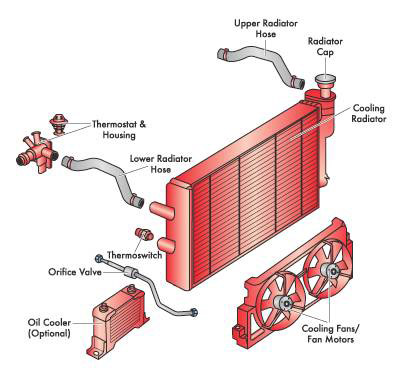Car Care - About Engine Cooling & Heating
Your vehicle has five principle components in its cooling system.
- Radiator — an auto radiator has a set of tubes called the "core" that the coolant flows through. Cooling fins surround the core. As air passes through the fins, the coolant releases its heat to the fins, which dissipate the heat.
- Radiator cap — there has to be a place to pour in coolant and the radiator cap covers that filling hole. The cap is also designed to seal the system to a specific pressure.
- Radiator hoses — the coolant goes from the radiator to the engine through a series of hoses that are sturdy and flexible enough to handle engine vibration and high heat.
- Thermostat — like the device on your home heating/cooling system, the engine thermostat keeps the engine at the proper operating temperature.
- Water pump — this is the heart of the engine cooling system. It pumps coolant through the whole cooling system and into the engine block.

What to Watch For
Engine overheating can come from a variety of sources. With combustion temperatures reaching 2000° F and higher, there is a lot of heat to dissipate. If your engine is running hotter than normal, either shortly after starting or over time, it's probably time for an inspection.
Check to see if any green, orange, or yellow fluid has formed under the vehicle. If it has, you are probably losing coolant, which could indicate a leak in the system. Loose or improperly adjusted belts and hoses, leaking gaskets or components, and even mechanical engine damage could be the culprit. Our technicians have the knowledge and expertise to correctly diagnose and repair your system.